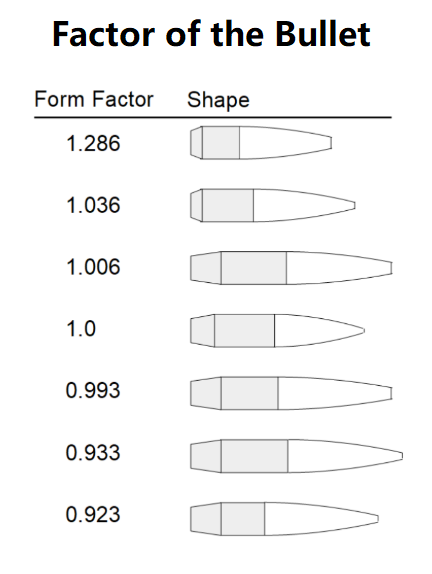 Home
Home
 Back
Back

Definition: This calculator determines the ballistic coefficient (\( BC \)) of a bullet, based on its mass (\( M \)), diameter (\( d \)), and form factor (\( i \)), using the sectional density (\( SD = M / d^2 \)).
Purpose: It assists ballistics experts and enthusiasts in evaluating a bullet’s aerodynamic performance and resistance to air drag.
The calculator uses the relationships:
Where:
Explanation: Enter the bullet mass, diameter, and form factor in the chosen units, and the calculator converts them to pounds and inches to compute the sectional density and ballistic coefficient. Results use scientific notation (5 decimal places) if the coefficient is greater than 10000 or less than 0.00001, otherwise 3 decimal places for precision with small values. For the image inputs (\( M = 25 \, \text{gr} \), \( d = 5 \, \text{mm} \), \( i = 58 \)), the calculated \( BC \) is approximately 0.002.
Definition: Form Factor refers to the shape or design of the bullet. It encompasses various characteristics such as the bullet's overall shape, weight distribution, and features like the nose profile. The form factor can impact the bullet's aerodynamics, stability during flight, and terminal ballistics (behavior upon impact). Different form factors are often associated with specific bullet types, such as full metal jacket, hollow point, or soft point bullets.
Examples: Berger Ammunition lists the following for their low form factor bullets:
Manufacturers design bullets with different form factors to achieve specific performance characteristics for various applications, such as target shooting, self-defense, or hunting.
Definition: The term "caliber" when referring to firearms and ammunition is a measure of the internal diameter of a gun barrel or the diameter of a bullet. It is usually expressed in inches or millimeters. The diameter of the bullet or the bore of the gun is a critical factor in determining the appropriate ammunition for a particular firearm.
Example: If a firearm has a caliber of .45 inches, it means that the internal diameter of the gun barrel is approximately 0.45 inches. In the context of ammunition, a bullet designed for a .45 caliber firearm would also have a diameter of around 0.45 inches.
Importance: Caliber is just one aspect of the overall cartridge specification. The complete cartridge information typically includes the caliber, cartridge length, and sometimes additional information, such as the specific type of ammunition or load. Understanding the correct caliber is crucial for selecting the right ammunition for a firearm to ensure proper function and safety.
Common Calibers: There are numerous bullet calibers used in firearms, varying widely depending on the type of firearm and its intended purpose. Here are some examples:
When selecting ammunition for a firearm, it’s crucial to use the correct caliber and type specified by the firearm’s manufacturer. Mixing incompatible calibers can be dangerous and may result in malfunctions or accidents.
Details: The ballistic coefficient is a key parameter in ballistics, indicating how well a bullet maintains velocity and resists air drag, influencing range and accuracy.
Tips: Enter positive values for mass, diameter, and form factor, and ensure \( d \neq 0 \) and \( i \neq 0 \), then click "Calculate." Results show the ballistic coefficient as a dimensionless value (scientific notation with 5 decimal places if > 10000 or < 0.00001, otherwise 3 decimal places).